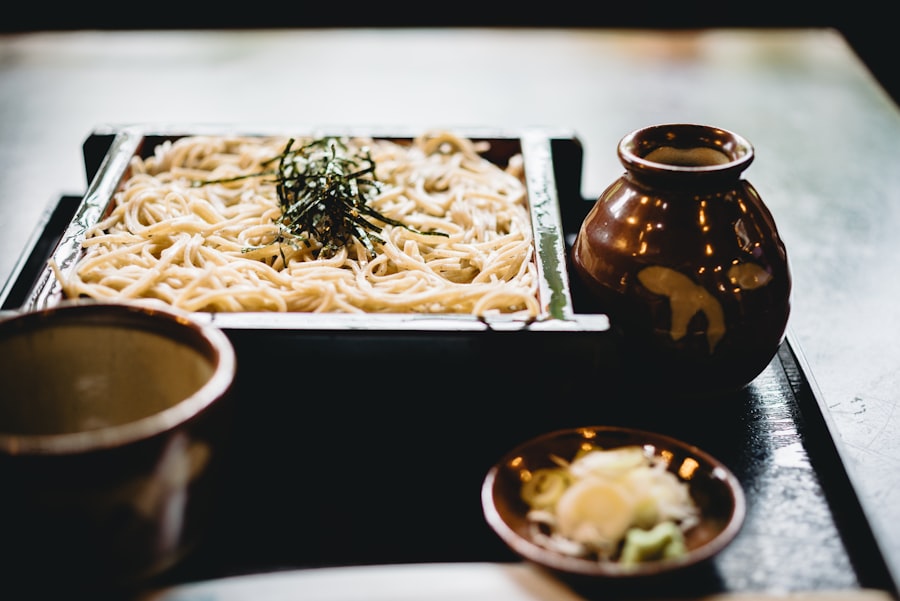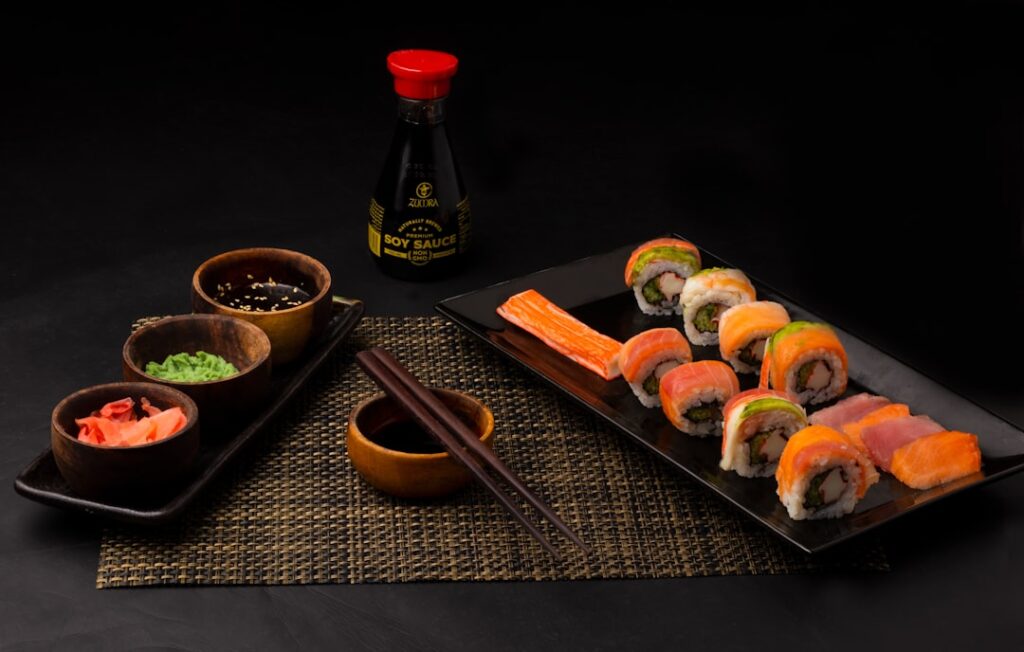Stepping into a traditional Japanese restaurant is akin to entering a serene sanctuary, where the hustle and bustle of the outside world fades away. The ambiance is meticulously crafted to evoke a sense of tranquility and harmony, often characterized by minimalist design elements that reflect the principles of Zen. Soft lighting, typically emanating from paper lanterns or subtle wall sconces, casts a warm glow over wooden tables and tatami mat seating.
The gentle sound of water trickling from a small indoor fountain or the soft rustle of bamboo adds to the calming atmosphere, creating an environment that invites diners to relax and immerse themselves in the culinary journey ahead. The decor often features natural materials such as wood, stone, and paper, which are integral to traditional Japanese aesthetics. Walls adorned with calligraphy or delicate ink paintings depict scenes from nature, while seasonal flower arrangements, known as Ikebana, bring a touch of life and color to the space.
The layout is designed to promote intimacy and connection, with private booths or low tables that encourage conversation among diners. This thoughtful arrangement not only enhances the dining experience but also reflects the Japanese cultural emphasis on community and togetherness. As guests settle in, they are enveloped in an atmosphere that is both inviting and reverent, setting the stage for an unforgettable meal.
The Menu: A Fusion of Traditional and Modern Japanese Cuisine
The menu at a Japanese restaurant often serves as a canvas where tradition meets innovation, showcasing a diverse array of dishes that pay homage to age-old culinary practices while embracing contemporary flavors and techniques. Diners can expect to find classic staples such as sushi, sashimi, and ramen alongside inventive creations that incorporate global influences. This fusion approach allows chefs to experiment with ingredients and presentation styles, resulting in a menu that is both familiar and exciting.
For instance, while traditional sushi may feature fresh fish and vinegared rice, modern interpretations might include unique toppings like truffle oil or spicy aioli, elevating the dish to new heights. Similarly, ramen, a beloved comfort food, can be reimagined with unconventional broths or garnishes that reflect seasonal ingredients or regional specialties. This blending of old and new not only caters to diverse palates but also encourages diners to explore the rich tapestry of Japanese cuisine in a fresh context.
Each dish tells a story, inviting guests to appreciate the culinary heritage while also embracing the creativity of contemporary chefs.
The Chef: A Master of Miso and Teriyaki

At the heart of any exceptional Japanese dining experience is the chef, whose expertise and passion for the craft are evident in every dish served. A master of miso and teriyaki, this culinary artist has honed their skills through years of training and dedication to the art of Japanese cooking. Miso, a fermented soybean paste, is a cornerstone of Japanese cuisine, known for its umami-rich flavor profile.
The chef skillfully incorporates various types of miso into soups, marinades, and dressings, enhancing the depth of flavor in each dish. Teriyaki, another hallmark of Japanese cooking, showcases the chef’s ability to balance sweet and savory elements. By expertly grilling or broiling meats and vegetables glazed with a homemade teriyaki sauce—crafted from soy sauce, mirin, and sugar—the chef creates dishes that are not only delicious but also visually appealing.
Their attention to detail extends beyond flavor; each plate is a testament to their commitment to aesthetics and presentation. The chef’s passion for their craft is palpable, as they strive to create an unforgettable dining experience that resonates with guests long after they leave the table.
The Ingredients: Fresh and Authentic Japanese Flavors
| Ingredient | Origin | Flavor Profile |
|---|---|---|
| Soy Sauce | Japan | Salty, Umami |
| Miso | Japan | Savory, Earthy |
| Wasabi | Japan | Spicy, Pungent |
| Seaweed (Nori) | Japan | Briny, Earthy |
The foundation of any great dish lies in its ingredients, and in Japanese cuisine, freshness is paramount. Chefs source high-quality produce, seafood, and meats that reflect the seasons and regional specialties. For instance, sushi-grade fish is often procured from local markets or directly from fishermen who adhere to sustainable practices.
This commitment to freshness ensures that each bite bursts with flavor and authenticity. In addition to seafood, vegetables play a crucial role in Japanese cooking. Seasonal ingredients such as daikon radish, shiso leaves, and bamboo shoots are carefully selected for their taste and texture.
These ingredients are often prepared using techniques that highlight their natural flavors—whether through pickling, steaming, or grilling—allowing them to shine on their own or complement other elements on the plate. The use of authentic Japanese condiments like soy sauce, wasabi, and sesame oil further enhances the overall flavor profile of each dish. By prioritizing fresh and authentic ingredients, chefs create meals that not only satisfy the palate but also honor the rich culinary traditions of Japan.
The Presentation: A Feast for the Eyes
In Japanese culture, food presentation is considered an art form in its own right. Each dish is thoughtfully arranged to create a visual feast that reflects the beauty of nature and the changing seasons. The use of color, texture, and shape plays a significant role in this aesthetic approach.
For example, vibrant greens from fresh vegetables may be juxtaposed against the deep reds of grilled meats or the delicate whites of rice, creating a harmonious balance on the plate. Ceramics and tableware also contribute to the overall presentation. Traditional Japanese dishes are often served on handcrafted plates or bowls that showcase intricate designs or natural motifs.
This attention to detail extends beyond mere aesthetics; it embodies the philosophy of “wabi-sabi,” which celebrates imperfection and transience in beauty. As diners admire their meals before taking the first bite, they are reminded that food is not just sustenance but also an experience meant to be savored with all senses engaged.
The Experience: Savoring the Flavors of Japan

The Ritual of Dining
From the moment guests enter until they take their last sip of tea, every aspect is designed to enhance their enjoyment. The ritualistic nature of dining—such as bowing upon greeting staff or expressing gratitude before meals—adds layers of cultural significance that enrich the experience.
A Symphony of Flavors
As diners savor each dish, they embark on a journey through flavors that tell stories of tradition and innovation. The careful balance of sweet, salty, sour, and umami creates a symphony on the palate that invites contemplation and enjoyment. Whether it’s the delicate texture of sashimi melting in one’s mouth or the comforting warmth of a bowl of ramen on a chilly evening, each bite evokes emotions tied to memory and place.
Sharing and Connecting
Moreover, sharing dishes among friends or family fosters connection and conversation—a hallmark of Japanese dining culture. As guests pass plates around the table or engage in discussions about flavors and techniques, they create lasting memories that extend beyond the meal itself. This communal aspect transforms dining into an event filled with laughter and camaraderie, making it an experience that resonates long after the last course has been served.


